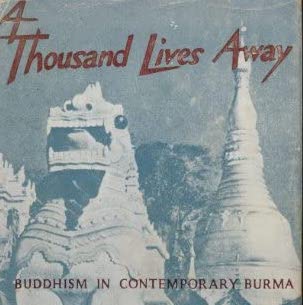A Thousand Lives Away: Buddhism in Contemporary Burma
By Winston J. King, forward by Edward Conze.
Reissued by Asian Humanities Press: Fremont, California, 1990,
238 pp., paper, $15.95.
I arrived in Burma a few days short of a day that was being hyped around the world as the Harmonic Convergence, in 1987. And while harmony did appear to be breaking out around the world, Burma was experiencing anything but. The military government, in order to regain control of what was essentially a completely blackmarket economy, declared several denominations of currency as good as wallpaper. The effect of that decision led the population to organize against those in power, and the results are still being felt. The monastic community involved itself heavily for the first time in political action. The elections, which invalidated the military’s claim of support, were summarily ignored, and the opposition as well as large numbers of monks have been imprisoned and tortured.
Against this background, the reissue of Winston L. King’s book, A Thousand Lives Away: Buddhism In Contemporary Burma, the result of two years’ residence in Rangoon from 1958-60, is timely, for it examines the then nascent stirrings of interest in secular affairs within the monastic community.
The reissue permits a look at the interplay between the religious and political communities, and investigates a new development in Burmese Buddhism—its worldwide missionizing and the establishment of traditional temples where lay people are taught the techniques of Vipassana meditation.
King spends a lot of time up front explaining the doctrine of annica (impermanence), anatta (egolessness), and dukkha (suffering) for those new to Buddhist teachings. But even for the initiated, this review becomes important as King then attempts to show how these doctrines both reinforce and conflict with less orthodox Burmese practices. As an outsider, King objectively views the varieties of Burmese Buddhism, from the popular worship of nats (pre-Buddhist animistic gods recast in the Burmese Buddhist cosmology) to the Theravadan orthodoxy of the Burmese monasticism. His analysis of the relationship between various popular, devotional practices, and the training of the monastics, as well as his examination of the tensions between popular cosmology and that of the “purer” Buddhism, offers instructive insights into the flexibility of Buddhism.
King also contrasts Burma with Tibet, where traditionally the government and the religious establishment were one, and with Thailand, where the king has always been considered a Buddha-to-be. In Burma, historically the political-secular power has been separate from the religious hierarchy. Of course, Burma has never had a stable political structure or ruling dynasty. King’s analysis of how this has affected the community’s relations with those in power is important for understanding the situation today.
Unfortunately, in his examination of cosmology and the impact of twentieth-century developments in science on Buddhism in Burma, King seems to want to score points against what he views as the trend in contemporary Buddhism to find a justification and proof of the Buddha’s message in the new physics. Certainly he makes some good points, but not without a measure of sour grapes. The Buddhist attitude toward scientific advances contrasts with the long antipathy between Christianity and science in the West, and this clearly makes King uncomfortable.
Perhaps the most important part of the book is the last chapter, which discusses meditation. Written long before the establishment of worldwide Vipassana meditation centers, it offers a good history of the resurgence of interest in this technique in Burma, as well as a look at the jhanic meditative tradition.
An appendix offers a first-person account of a ten-day course in Vipassana at the center of U Ba Khin, a lay master. For those unfamiliar with the discipline as taught and practiced in Burma, this serves as an excellent introduction. For those acquainted with this lineage, the chapter on meditation and the account of one man’s experience in Vipassana is a welcome addition to the growing English library on this tradition. As a student of the Vipassana teacher S. N. Goenka, I was fascinated to read about the rise of Vipassana as a somewhat protestant reaction by the laymen to the monastic tradition.
King has clearly written A Thousand Lives Away for newcomers to Buddhism, but the book will also interest students of meditation, as well as those exploring Western ideas, scientific theories, and Eastern cosmology. In addition, it is an instructive profile of a nation that claims to be the purest stronghold of the Theravadan Buddhist tradition.
Thank you for subscribing to Tricycle! As a nonprofit, we depend on readers like you to keep Buddhist teachings and practices widely available.
